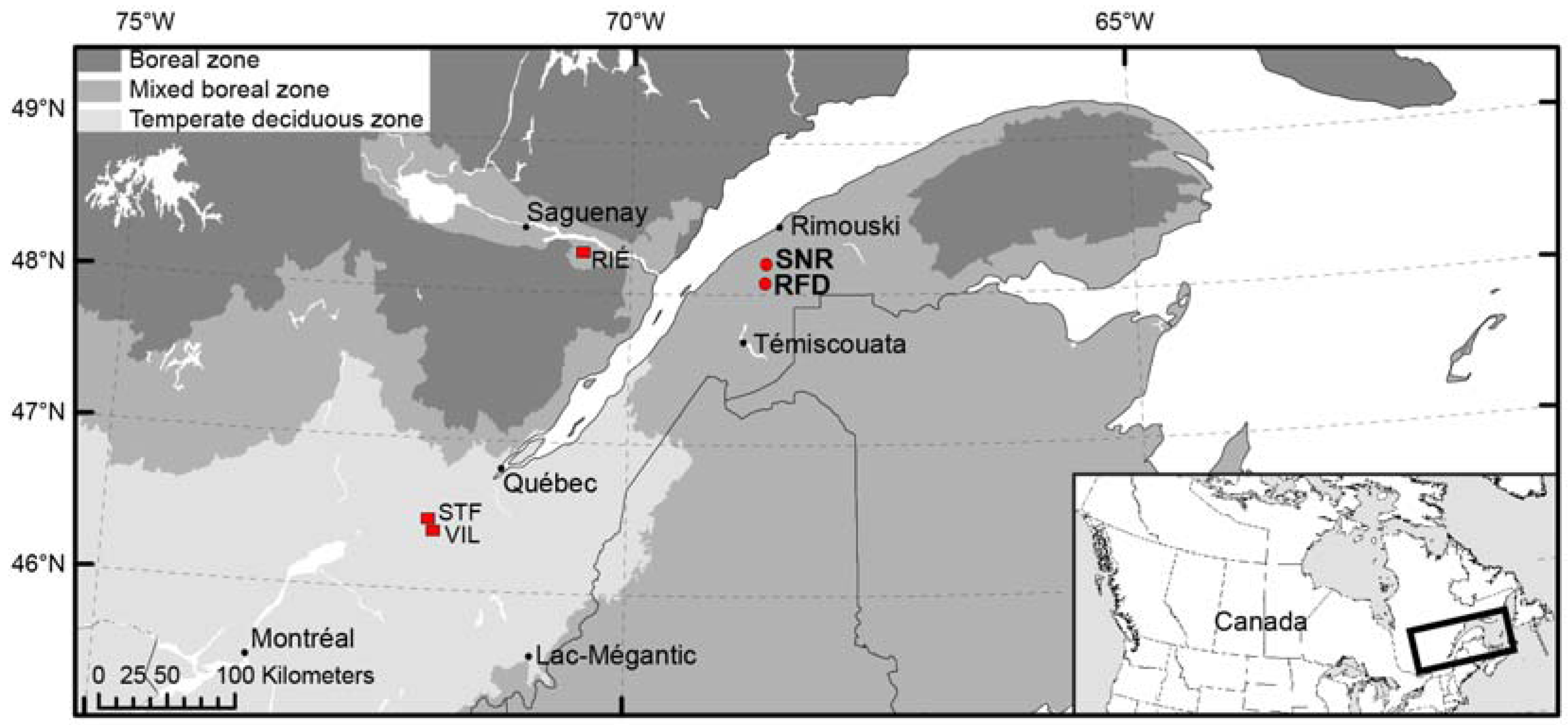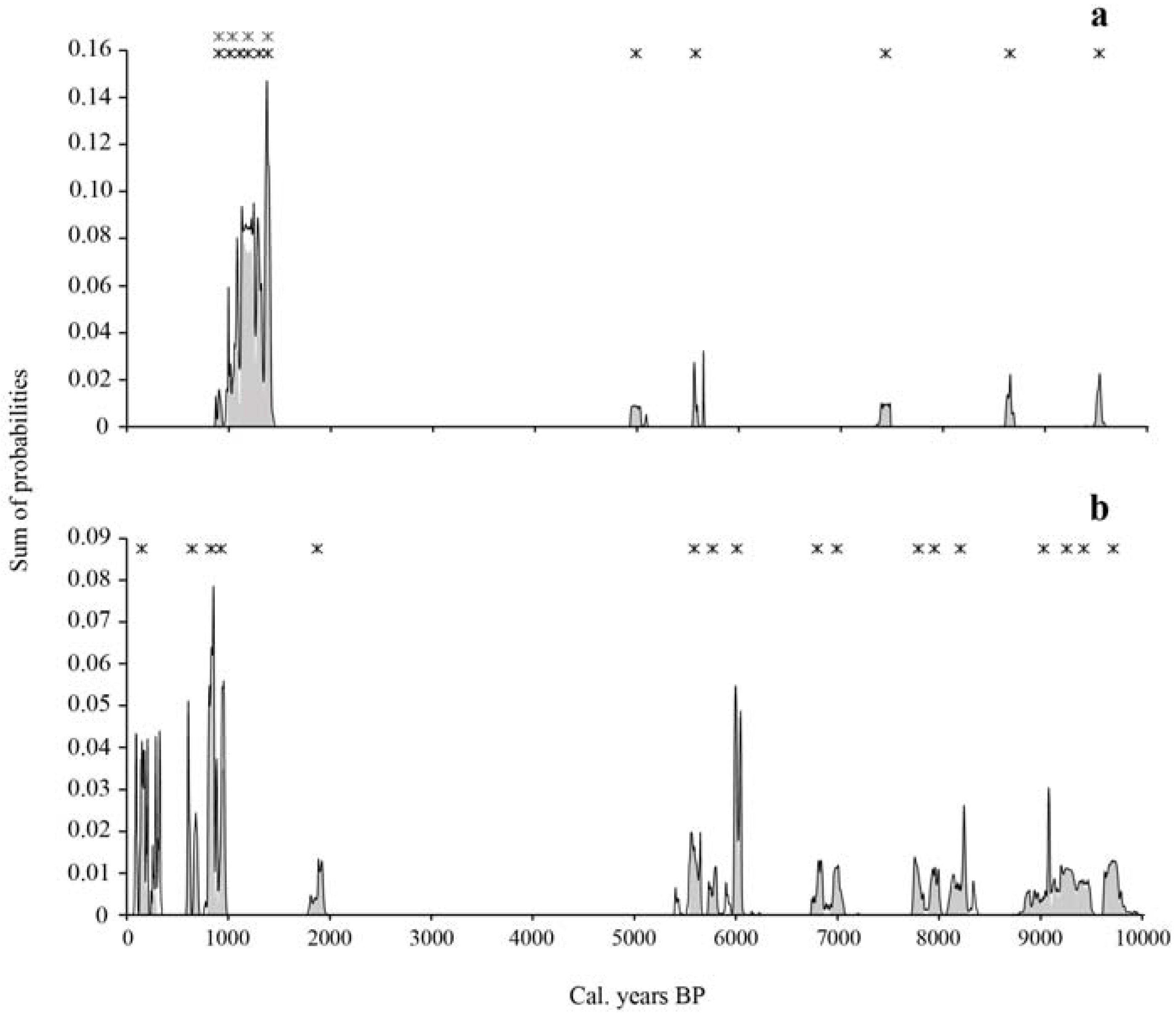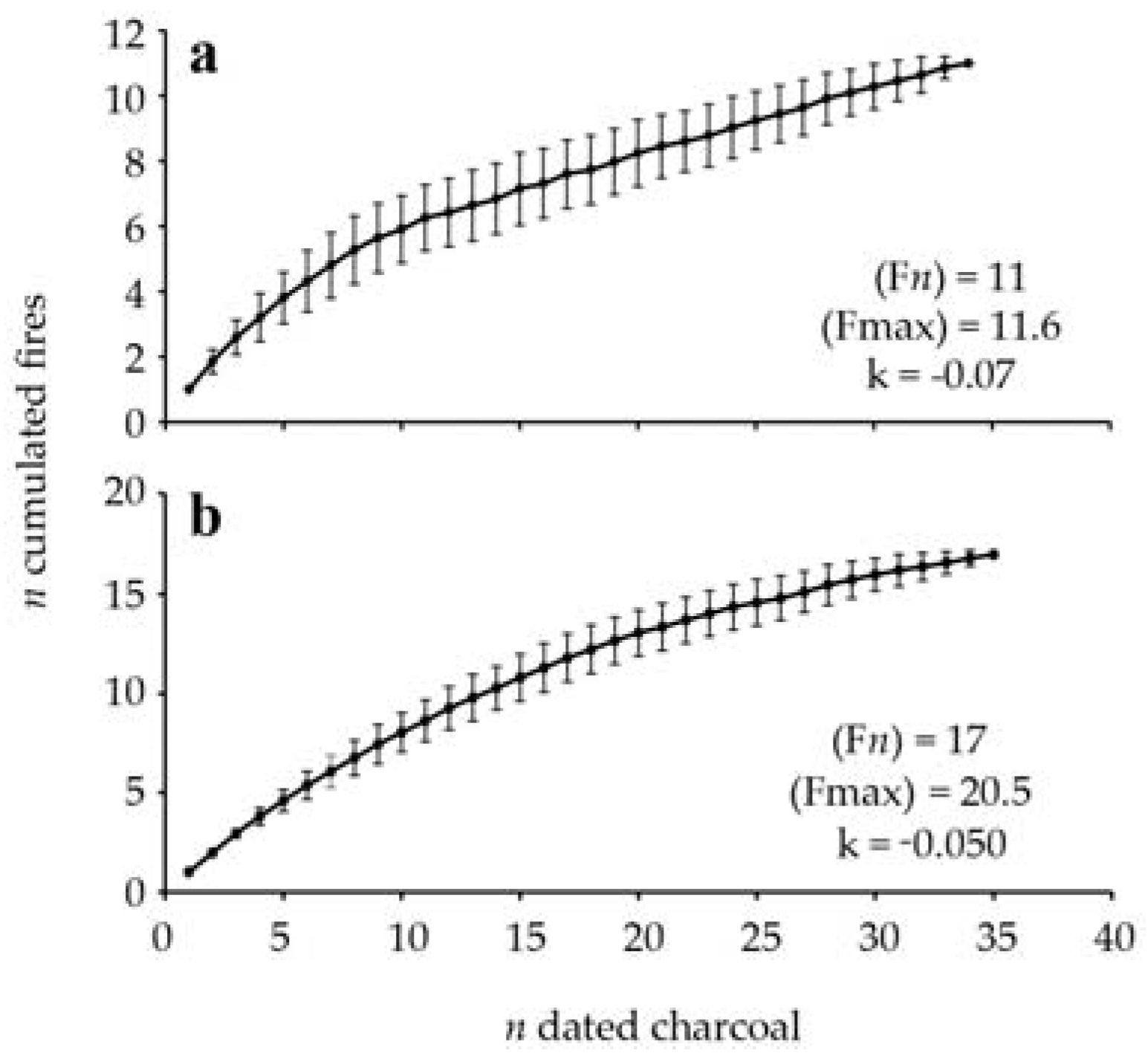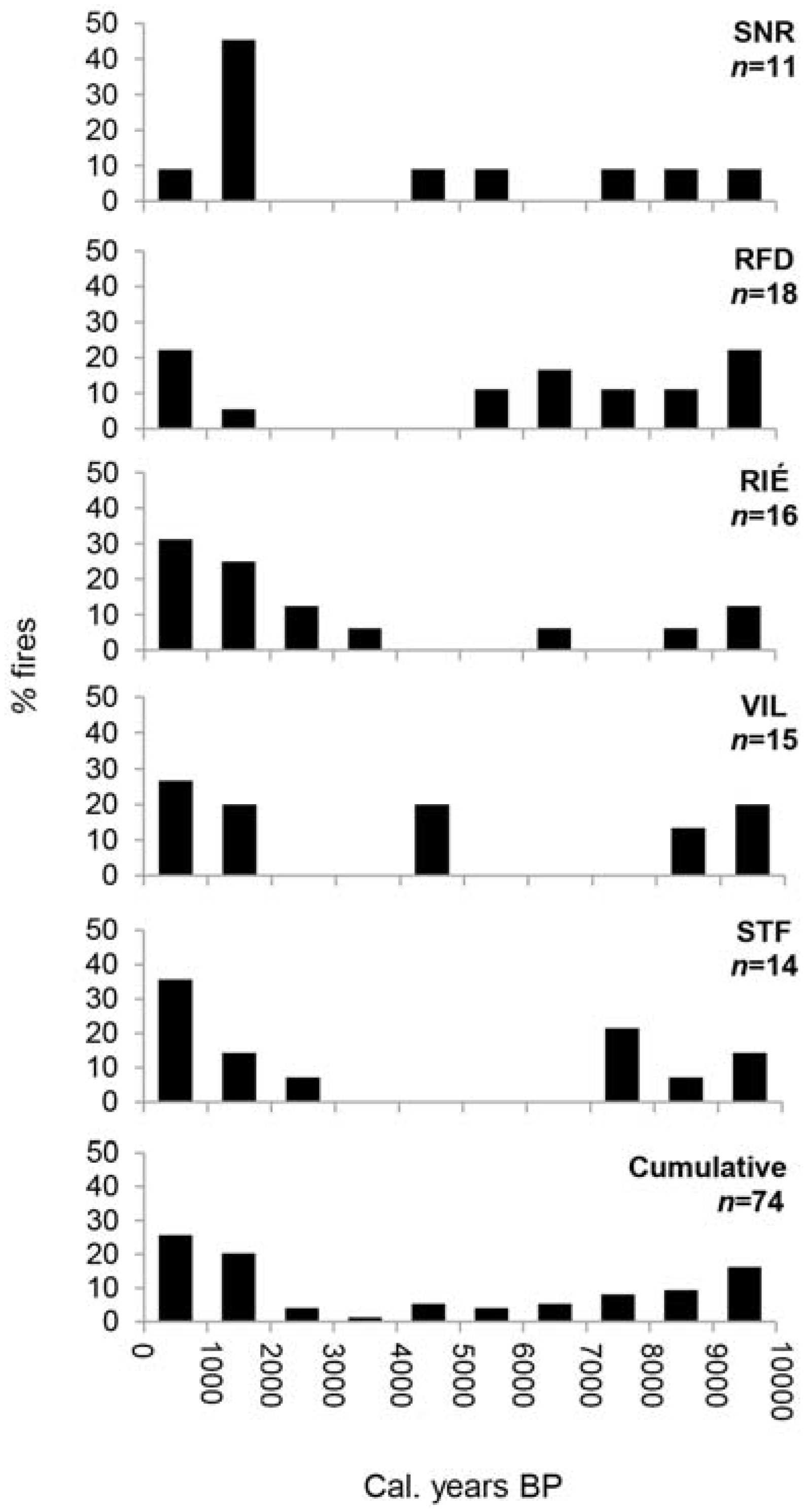Fire History of Appalachian Forests of the Lower St-Lawrence Region (Southern Quebec)
Abstract
:1. Introduction
2. Materials and Methods
2.1. Study Area
2.2. Field Sampling and Sample Treatment
2.3. Charcoal Dating and Fire History
3. Results
3.1. Charcoal Species of the Nicolas-Riou Seigneury Site
3.1.1. Fire Periods
3.1.2. Macrocharcoal Assemblage
3.2. Charcoal Species of the Duchénier Faunal Reserve Site
3.2.1. Fire Periods
3.2.2. Macrocharcoal Assemblage
4. Discussion
5. Conclusions
Acknowledgments
Author Contributions
Conflicts of Interest
References
- Bonnicksen, T.M. America’s Ancient Forests: From the Ice Age to the Age of Discovery; John Wiley & Sons, Inc.: New York, NY, USA, 2000. [Google Scholar]
- Bureau, L. Les Solitudes de Lotbinière. Master’s Thesis, Université Laval, Québec, QC, Canada, 1968. [Google Scholar]
- Clark, J.S. Transformation of a northern hardwood forest by aboriginal (Iroquois) fire: Charcoal evidence from Crawford Lake, Ontario, Canada. Holocene 1995, 5, 1–9. [Google Scholar] [CrossRef]
- Fahey, T.J.; Reiners, W.A. Fire in the forests of Maine and New Hampshire. Bull. Torrey Bot. Club 1981, 108, 362–373. [Google Scholar] [CrossRef]
- Lorimer, C.G. The presettlement forest and natural disturbance cycle of northeastern Maine. Ecology 1977, 58, 139–148. [Google Scholar] [CrossRef]
- Lortie, M. Arbres, Forêts et Perturbations Naturelles au Québec; Les Presses de l’Université Laval: Québec, QC, Canada, 1979. [Google Scholar]
- Oliver, C.D.; Stephens, E.P. Reconstruction of a mixed-species forest in central New England. Ecology 1977, 58, 562–572. [Google Scholar] [CrossRef]
- Patterson, W.A.; Sassaman, K.E. Indian fires in the prehistory of New England. In Holocene Human Ecology in Northeastern North America; Nicholas, G., Ed.; Plenum: New York, NY, USA, 1988; pp. 107–135. [Google Scholar]
- Terrail, R. Influence de la Colonisation sur les Transformations du Paysage Forestier Depuis L’époque Préindustrielle dans l’Est du Québec. Ph.D. Thesis, UQAM, Montréal, QC, Canada, 2013. [Google Scholar]
- Clark, J.S.; Royall, P.D. Local and regional sediment charcoal evidence for fire regimes in presettlement north–eastern North America. J. Ecol. 1996, 84, 365–382. [Google Scholar] [CrossRef]
- Woods, K.D. Intermediate disturbance in a late-successional hemlock-northern hardwood forest. J. Ecol. 2004, 92, 464–476. [Google Scholar] [CrossRef]
- Grandtner, M.M. La Végétation Forestière du Québec Méridional; Les Presses de l’Université Laval: Québec, QC, Canada, 1966. [Google Scholar]
- Forcier, L.K. Reproductive strategies and the co-occurrence of climax tree species. Science 1975, 189, 808–811. [Google Scholar] [CrossRef] [PubMed]
- Payette, S.; Filion, L.; Delwaide, A. Disturbance regime of a cold temperate forest as deduced from tree–ring patterns: The Tantaré Ecological Reserve, Quebec. Can. J. For. Res. 1990, 20, 1228–1241. [Google Scholar] [CrossRef]
- Runkle, J.R. Gap regeneration in some old-growth forest of the eastern United States. Ecology 1981, 62, 1041–1051. [Google Scholar] [CrossRef]
- Houle, G.; Payette, S. Seed dynamics of Abies balsamea and Acer saccharum in a deciduous forest of northeastern North America. Am. J. Bot. 1991, 78, 895–905. [Google Scholar] [CrossRef]
- Boucher, Y.; Arseneault, D.; Sirois, L. Logging-induced change (1930–2002) of a preindustrial landscape at the northern range limit of northern hardwoods, eastern Canada. Can. J. For. Res. 2006, 36, 505–517. [Google Scholar] [CrossRef]
- Brown, J.L. Les forêts du Témiscamingue, Québec: Ecologie et Photo-Interprétation; Laboratoire d’Écologie Forestière, Université Laval: Québec, QC, Canada, 1981. [Google Scholar]
- Dupuis, S.; Arseneault, D.; Sirois, L. Change from pre-settlement to present–day forest composition reconstructed from early land survey records in eastern Québec, Canada. J. Veg. Sci. 2011, 22, 564–575. [Google Scholar] [CrossRef]
- Brisson, J.; Bergeron, Y.; Bouchard, A. Les successions secondaires sur sites mésiques dans le Haut-Saint-Laurent, Québec, Canada. Can. J. Bot. 1988, 66, 1192–1203. [Google Scholar] [CrossRef]
- Bilodeau, J. Écologie des érablières à sucre (Acer saccharum Marsh.) à leur limite nord de distribution au Saguenay-Lac-Saint-Jean. Master’s Thesis, UQAC, Chicoutimi, QC, Canada, 1992. [Google Scholar]
- Nolet, P.; Delagrange, S.; Bouffard, D.; Doyon, F.; Forget, E. The successional status of sugar maple (Acer saccharum), revisited. Ann. For. Sci. 2008, 65, 208–217. [Google Scholar] [CrossRef]
- Pilon, V.; Payette, S. Sugar maple (Acer saccharum) forests at their northern distribution limit are recurrently impacted by fire. Can. J. For. Res. 2015, 45, 452–462. [Google Scholar] [CrossRef]
- Asnong, H.; Richard, P.J.H. La végétation et le climat postglaciaires du centre et de l’est de la Gaspésie, au Québec. Géogr. Phys. Quat. 2003, 57, 37–63. [Google Scholar] [CrossRef]
- Elkadi, T. L’histoire Postglaciaire de la Végétation et des Feux de la Région du Lac Mégantic. Master’s Thesis, Université de Montréal, Montréal, QC, Canada, 2013. [Google Scholar]
- Labelle, C.; Richard, P.J.H. Végétation tardiglaciaire et postglaciaire au sud-est du Parc des Laurentides. Géogr. Phys. Quat. 1981, 35, 345–359. [Google Scholar] [CrossRef]
- Talon, B.; Payette, S.; Filion, L.; Delwaide, A. Reconstruction of the long-term fire history of an old-growth deciduous forest in southern Québec, Canada, from charred wood in mineral soils. Quat. Res. 2005, 64, 36–43. [Google Scholar] [CrossRef]
- Frégeau, M.; Payette, S.; Grondin, P. Fire history of the central boreal forest in eastern North America reveals stability since the mid-Holocene. Holocene 2015, 25, 1912–1922. [Google Scholar] [CrossRef]
- Payette, S.; Delwaide, A.; Schaffhauser, A.; Magnan, G. Calculating long–term fire frequency at the stand scale from charcoal data. Ecosphere 2012, 3, 59. [Google Scholar] [CrossRef]
- Payette, S.; Pilon, V.; Couillard, P.L.; Frégeau, M. Long-term fire history of maple (Acer) forest sites in the central St. Lawrence Lowland, Quebec. Can. J. For. Res. 2016, 46, 822–831. [Google Scholar] [CrossRef]
- Arseneault, D.; (UQAR, Rimouski, Quebec, QC, Canada). Personal communication, 2013.
- Fonds de la compagnie Price Brothers, P666. Archives nationales du Québec à Saguenay: Saguenay, QC, Canada.
- Ohlson, M.; Tryterud, E. Interpretation of the charcoal record in forest soils: Forest fires and their production and deposition of macroscopic charcoal. Holocene 2000, 10, 519–525. [Google Scholar] [CrossRef]
- Hoadley, R.B. Identifying Wood: Accurate Results with Simple Tools; Taunton Press: Newtown, CT, USA, 1990. [Google Scholar]
- Inside Wood. Available online: http://insidewood.lib.ncsu.edu/search (accessed on 23 December 2016).
- Panshin, A.J.; de Zeeuw, C. Textbook of Wood Technology, 4th ed.; McGraw-Hill: New York, NY, USA, 1980. [Google Scholar]
- Stuiver, M.P.; Reimer, P.J.; Reimer, R.W. CALIB 7.02. (Computer Program and Documentation). 2013. Available online: http://radiocarbon.pa.qub.ac.uk/calib/ (accessed on 12 March 2014).
- Reimer, P.J.; Bard, E.; Bayliss, A.; Beck, J.W.; Blackwell, P.G.; Ramsey, C.B.; Buck, C.E.; Cheng, H.; Edwards, R.L.; Friedrich, M.; et al. IntCal13 and Marine13 radiocarbon age calibration curves 0–50000 years cal BP. Radiocarbon 2013, 55, 1869–1887. [Google Scholar] [CrossRef]
- Solanki, S.K.; Usoskin, I.G.; Kromer, B.; Schüssler, M.; Beer, J. Unusual activity of the sun during recent decades compared to the previous 11,000 years. Nature 2004, 431, 1084–1087. [Google Scholar] [CrossRef] [PubMed]
- Pilon, V.; Payette, S.; Couillard, P.L.; Laflamme, J. Surface analysis as a tool to reconstruct the recent development of two contrasted sugar maple forests. 2017; Manuscript in preparation. [Google Scholar]
- Kindt, R.; Coe, R. Tree Diversity Analysis: A Manual and Software for Common Statistical Methods for Ecological and Biodiversity Studies; World Agroforestry Centre (ICRAF): Nairobi, Kenya, 2005. [Google Scholar]
- R Development Core Team. R: A Language and Environment for Statistical Computing; R Foundation for Statistical Computing: Vienna, Austria, 2011. [Google Scholar]
- Soberon, J.; Llorente, J. The use of species accumulation functions for the prediction of species richness. Conserv. Biol. 1993, 7, 480–488. [Google Scholar] [CrossRef]
- Boucher, Y.; Arseneault, D.; Sirois, L. Logging-history (1820–2000) of a heavily exploited southern boreal forest landscape: Insights from sunken logs and forestry maps. For. Ecol. Manag. 2009, 258, 1359–1368. [Google Scholar] [CrossRef]
- Richard, P.J.H.; Larouche, A.C.; Lortie, G. Paléophytogéographie et paléoclimats postglaciaires dans l’ouest du Bas-Saint-Laurent, Québec. Géogr. Phys. Quat. 1992, 46, 151–172. [Google Scholar] [CrossRef]
- Richard, P.J.H.; Larouche, A.C. Histoire postglaciaire de la végétation et du climat dans la région de Rimouski, Québec. In Il y a 8000 ans à Rimouski, Paléoécologie et Archéologie d’un Site de la Culture Plano; Chapdelaine, C., Ed.; Collection Paléo-Québec No. 22; Recherches amérindiennes au Québec: Montréal, QC, Canada, 1994; pp. 49–89. [Google Scholar]
- Archambault, L.; Morissette, J.; Bernier-Cardou, M. Succession forestière après feu dans la sapinière à bouleau jaune du Bas-Saint-Laurent, Québec. For. Chron. 1997, 73, 702–710. [Google Scholar] [CrossRef]
- Fesenmyer, K.A.; Christensen, N.L., Jr. Reconstructing Holocene fire history in a southern Appalachian forest using soil charcoal. Ecology 2010, 91, 662–670. [Google Scholar] [CrossRef] [PubMed]
- Hart, J.L.; Horn, S.P.; Grissino-Mayer, H.D. Fire history from soil charcoal in a mixed hardwood forest in the Cumberland Plateau, Tennessee, USA. J. Torrey Bot. Soc. 2008, 135, 401–410. [Google Scholar] [CrossRef]
- Touflan, P.; Talon, B.; Walsh, K. Soil charcoal analysis: A reliable tool for spatially precise studies of past forest dynamics: A case study in the French Southern Alps. Holocene 2010, 20, 45–52. [Google Scholar] [CrossRef]
- Sorel, C. Impacts des Perturbations Anthropiques du XXe Siècle sur Deux Forêts du Bas-Saint-Laurent (Québec). Master’s Thesis, UQAR, Rimouski, QC, Canada, 2004. [Google Scholar]




| Layer | Species | SNR | RFD |
|---|---|---|---|
| Tree | Abies balsamea (L.) Mill, | x | x |
| Acer rubrum L. | 1 tree | ||
| Acer saccharum Marsh. | x | x | |
| Betula alleghaniensis Britton | x | x | |
| Betula papyrifera Marsh. | x | ||
| Picea glauca (Moench) Voss | x | x | |
| Pinus strobus L. | 1 seedling | ||
| Thuja occidentalis L. | x | x | |
| Shrub | Acer pensylvanicum L. | x | x |
| Acer spicatum Lam. | x | ||
| Corylus cornuta Marsh. | x | x | |
| Lonicera canadensis Bartr. ex Marsh. | x | ||
| Rubus idaeus L. | x | ||
| Sorbus sp. | seedlings | ||
| Taxus canadensis Marsh, | x | ||
| Herb | Actaea rubra (Aiton) Willd. | x | |
| Aralia nudicaulis L. | x | x | |
| Carex sp. | 1 individual | ||
| Circaea alpina L. | x | ||
| Dryopteris carthusiana (Vill.) H.P. Fuchs | x | x | |
| Galium sp. | x | ||
| Gymnocarpium disjunctum (Rupr.) Ching | x | ||
| Huperzia lucidula (Michaux) Trevisan | x | ||
| Hypopitys monotropa Crantz | x | x | |
| Lysimachia borealis (Raf.) U. Manns & Anderb. | x | x | |
| Mitella nuda L. | x | ||
| Osmundastrum sp. | x | ||
| Oxalis montana Raf. | x | ||
| Phegopteris connectilis (Michx.) Watt | x | x | |
| Rubus pubescens Raf. | x | ||
| Streptopus lanceolatus (Ait.) Reveal | x | x | |
| Trillium erectum L. | x | x |
| Charcoal Pieces | SNR | RFD | ||||
|---|---|---|---|---|---|---|
| Organic | Mineral a | n Microsite | Organic | Mineral | n Microsite | |
| Average weight (±σ) mg | 9.2 (±15.3) | 8.8 (±10.9) | ||||
| n extracted charcoal pieces | >800 | 211 | >1000 | 39 | ||
| Unidentified conifer | 48 | 27 | 14 | 133 | 9 | 17 |
| Picea sp. and Picea sp./Larix laricina | 2 | 10 | 5 | 75 | 4 | 8 |
| Abies balsamea/Thuja occidentalis b | 18 | 10 | 4 | 87 | 3 | 9 |
| Abies balsamea c | 13 | 2 | 8 | 45 | 2 | 7 |
| Thuja occidentalis | 6 | 1 | 2 | |||
| Taxus canadensis | 3 | 2 | ||||
| Unidentified broadleaf | 52 | 35 | 11 | 22 | 11 | |
| Betula sp. | 60 | 35 | 5 | 62 | 1 | 11 |
| Betulaceae | 13 | 4 | 3 | 3 | 2 | |
| Betulaceae shrub | 8 | 1 | 1 | 8 | 5 | 5 |
| Other shrub | 2 | 1 | ||||
| Broadleaf d | 15 | 2 | 3 | 13 | 2 | |
| Acer sp. | 3 | 3 | 1 | 19 | 1 | |
| Acer saccharum | 33 | 1 | 2 | 1 | 2 | |
| Populus sp./Salix sp. | 2 | 1 | ||||
| Unidentified pieces | 16 | 26 | 12 | 12 | 10 | 12 |
| Fungi | 10 | 3 | 33 | 11 | ||
| Leaf-bud | 2 | 2 | ||||
| Bark-pith | 40 | 29 | 9 | 79 | 3 | 15 |
| Microsite | Location | Sample Number a | Taxon or Piece | 14C Age (±σ) | Cal. Age | Probability | n Fires Cumulated |
|---|---|---|---|---|---|---|---|
| 14 | Mineral/organic contact | C-157758 | Picea sp./Larix laricina | 955 ± 15 | 865–935 | 0.69 | 11 |
| 6 | Mineral A | C-147457 | Conifer | 1015 ± 15 | 985–1025 | 1.00 | 10 |
| 14 | Organic | G-21386 | Abies balsamea/Thuja occidentalis | 1085 ± 20 | 1000–1075 | 0.70 | 9/10 |
| 17 | Mineral A | C-147888 | Acer sp. | 1135 ± 20 | 1035–1145 | 0.98 | 9 |
| 23 | Mineral A | C-147456 | Conifer | 1140 ± 15 | 1045–1140 | 0.99 | |
| 24 | Mineral/organic contact | C-157757 | Bark | 1155 ± 15 | 1110–1160 | 0.43 | 8/9 |
| 20 | Mineral A | C-147918 | Betulaceae, shrub | 1155 ± 20 | 1110–1215 | 0.58 | |
| 6 | Mineral B | C-147920 | Taxus canadensis | 1160 ± 20 | 1115–1240 | 0.79 | 8 |
| 4 | Mineral B | G-18880 | Conifer, vitrified | 1170 ± 20 | 1120–1240 | 0.93 | |
| 16 | Mineral/organic contact | C-157769 | cf. Acer saccharum | 1220 ± 15 | 1135–1230 | 0.73 | |
| 20 | Mineral/organic contact | C-157770 | cf. Corylus cornuta | 1190 ± 20 | 1130–1240 | 1.00 | |
| 24 | Mineral B | C-147919 | Structure without xylem /bark | 1190 ± 20 | 1130–1240 | 1.00 | |
| 24 | Mineral/organic contact | G-21403 | Picea sp./Larix laricina | 1200 ± 20 | 1130–1245 | 1.00 | |
| 16 | Organic | G-21405 | Abies balsamea (Tsuga) b | 1215 ± 20 | 1130–1250 | 0.92 | |
| 23 | Mineral B | C-147453 | Picea sp./Larix laricina | 1200 ± 15 | 1135–1240 | 1.00 | |
| 15 | Mineral A | C-147922 | Abies balsamea (Tsuga) b | 1210 ± 20 | 1130–1245 | 0.96 | |
| 13 | Mineral A | C-147887 | Abies balsamea | 1245 ± 20 | 1235–1330 | 0.87 | |
| 14 | Mineral A | G-18884 | Abies balsamea/Thuja occidentalis | 1250 ± 20 | 1240–1335 | 0.94 | 7 |
| 10 | Mineral B | C-147455 | Picea sp./Larix laricina | 1265 ± 15 | 1245–1330 | 1.00 | |
| 24 | Mineral A | C-147917 | Betula sp. | 1275 ± 20 | 1245–1340 | 1.00 | |
| 4 | Mineral A | C-147466 | Vitrified | 1235 ± 15 | 1270–1325 | 0.53 | |
| 24 | Mineral/organic contact | C-157771 | Betula sp. | 1275 ± 15 | 1285–1335 | 0.59 | |
| 11 | Mineral A | C-147916 | Abies balsamea (Tsuga) b | 1355 ± 20 | 1335–1370 | 1.00 | 6/7 |
| 18 | Organic | C-157761 | Betula sp. | 1385 ± 20 | 1350–1395 | 1.00 | |
| 18 | Organic | C-157760 | Betula sp. | 1410 ± 20 | 1355–1410 | 1.00 | 6 |
| 18 | Mineral A | G-18882 | Vitrified | 1420 ± 20 | 1360–1415 | 1.00 | |
| 18 | Mineral B | C-147454 | Betula sp. | 1425 ± 20 | 1360–1415 | 1.00 | |
| 11 | Mineral A | C-147465 | Vitrified | 1430 ± 15 | 1365–1415 | 1.00 | |
| 18 | Mineral/organic contact | G-21402 | Betula sp. | 1435 ± 20 | 1365–1425 | 1.00 | |
| 2 | Mineral A | C-147459 | Broadleaf | 4380 ± 20 | 4930–5040 | 0.92 | 5 |
| 20 | Mineral A | C-147458 | Conifer | 4810 ± 20 | 5545–5600 | 0.71 | 4 |
| 14 | Mineral A | C-147461 | Broadleaf (not Acer sp.) | 6430 ± 20 | 7375–7485 | 1.00 | 3 |
| 12 | Mineral B | C-147923 | Picea sp. | 7810 ± 25 | 8610–8695 | 1.00 | 2 |
| 12 | Mineral A | C-147460 | Conifer, vitrified | 8425 ± 25 | 9490–9570 | 0.99 | 1 |
| Microsite | Location | Sample Number a | Taxon or Piece | 14C Age (±σ) | Cal. Age | Probability | n Fires Cumulated |
|---|---|---|---|---|---|---|---|
| 3 | Mineral/organic contact | C-157767 | Picea sp. | 130 ± 15 | 125–185 | 0.39 | 17 |
| 3 | Mineral/organic contact | C-157751 | Bark | 130 ± 15 | 125–185 | 0.39 | |
| 3 | Organic | C-157768 | cf. Thuja occidentalis | 130 ± 15 | 125–185 | 0.39 | |
| 3 | Organic | C-157755 | Conifer | 115 ± 15 | 125–205 | 0.61 | |
| 3 | Organic | G-21385 | Bark | 140 ± 20 | 235–295 | 0.29 | |
| 3 | Mineral/organic contact | C-157754 | Broadleaf with spiral thickenings, lamellar | 545 ± 15 | 590–620 | 0.83 | 16 |
| 3 | Organic | C-157756 | Acer saccharum, lamellar | 595 ± 15 | 650–710 | 0.77 | |
| 14 | Mineral B | C-147925 | Thuja occidentalis | 855 ± 20 | 790–860 | 0.98 | 15 |
| 17 | Mineral A | C-148767 | Bark | 860 ± 20 | 790–860 | 0.98 | |
| 18 | Mineral B | C-148224 | Abies balsamea | 880 ± 20 | 800–865 | 0.77 | |
| 15 | Organic | C-157751 | cf. Abies balsamea | 890 ± 15 | 805–865 | 0.60 | |
| 21 | Organic | C-157766 | Betula sp., branch | 910 ± 20 | 845–980 | 0.99 | 14 |
| 15 | Mineral/organic contact | C-157750 | cf. Corylus cornuta | 905 ± 20 | 905–975 | 0.55 | |
| 23 | Mineral A | G-18883 | cf. Betulaceae, shrub | 905 ± 20 | 905–975 | 0.55 | |
| 11 | Mineral A | C-148765 | Conifer, altered | 1880 ± 25 | 1800–1945 | 1.00 | 13 |
| 5 | Mineral A | G-18876 | Acer saccharum | 4800 ± 25 | 5540–5610 | 0.80 | 12 |
| 4 | Mineral A | C-148770 | Vitrified, orange deposit | 4740 ± 25 | 5565–5650 | 0.61 | |
| 19 | Mineral A | C-148768 | Structure without xylem | 5005 ± 25 | 5720–5820 | 0.75 | 11 |
| 12 | Mineral B | C-148766 | Conifer, altered | 5185 ± 25 | 5975–6020 | 0.68 | 10 |
| 9 | Mineral A | C-148772 | Vitrified | 5200 ± 30 | 5975–6060 | 1.00 | |
| 2 | Mineral A | G-18885 | Abies balsamea (Tsuga) b | 5200 ± 25 | 5980–6055 | 1.00 | |
| 15 | Mineral A | C-148771 | Vitrified, orange deposit | 5935 ± 25 | 6740–6865 | 0.95 | 9 |
| 9 | Mineral A | G-18877 | Betula sp. | 6070 ± 25 | 6925–7065 | 1.00 | 8 |
| 23 | Mineral B | C-147924 | cf. Betulaceae shrub | 6895 ± 25 | 7740–7850 | 1.00 | 7 |
| 8 | Mineral B | C-148730 | Conifer, altered | 7050 ± 30 | 7895–8020 | 1.00 | 6 |
| 3 | Mineral B | C-148769 | Vitrified, orange deposit | 7310 ± 40 | 8085–8250 | 1.00 | 5 |
| 19 | Mineral A | G-18879 | Conifer, reaction wood | 7370 ± 25 | 8220–8290 | 0.66 | |
| 5 | Mineral A | G-18878 | Picea sp. | 7995 ± 25 | 8835–9065 | 1.00 | 4 |
| 13 | Mineral A | G-18881 | Vitrified, orange deposit | 8100 ± 25 | 9060–9155 | 1.00 | 3/4 |
| 22 | Mineral A | C-147926 | cf. Betulaceae shrub | 8210 ± 25 | 9145–9340 | 0.96 | 3 |
| 4 | Mineral A | C-148728 | Picea sp. | 8240 ± 35 | 9150–9380 | 0.94 | |
| 5 | Mineral B | C-147928 | Picea sp. | 8330 ± 25 | 9350–9500 | 1.00 | 2 |
| 6 | Mineral B | C-148729 | Conifer | 8690 ± 35 | 9610–9775 | 0.97 | 1 |
| 22 | Mineral A | G-18875 | Vitrified | 8720 ± 30 | 9615–9775 | 0.99 |
© 2017 by the authors. Licensee MDPI, Basel, Switzerland. This article is an open access article distributed under the terms and conditions of the Creative Commons Attribution (CC BY) license (http://creativecommons.org/licenses/by/4.0/).
Share and Cite
Payette, S.; Pilon, V.; Couillard, P.-L.; Laflamme, J. Fire History of Appalachian Forests of the Lower St-Lawrence Region (Southern Quebec). Forests 2017, 8, 120. https://doi.org/10.3390/f8040120
Payette S, Pilon V, Couillard P-L, Laflamme J. Fire History of Appalachian Forests of the Lower St-Lawrence Region (Southern Quebec). Forests. 2017; 8(4):120. https://doi.org/10.3390/f8040120
Chicago/Turabian StylePayette, Serge, Vanessa Pilon, Pierre-Luc Couillard, and Jason Laflamme. 2017. "Fire History of Appalachian Forests of the Lower St-Lawrence Region (Southern Quebec)" Forests 8, no. 4: 120. https://doi.org/10.3390/f8040120






